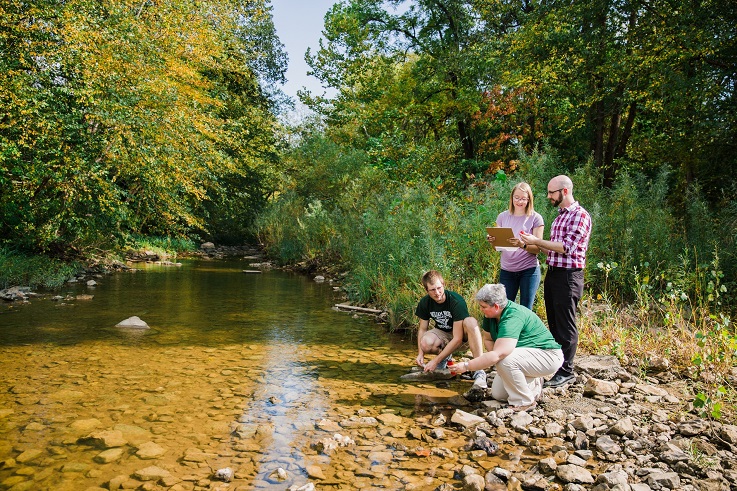From creek side to research bench, William Woods University biology and chemistry undergraduates gain hands-on insights

For the moment, a group of William Woods University biology and chemistry undergraduates taking water samples from Stinson Creek must keep the small picture — microscopic actually — front of mind as they try to understand organic pollutants that threaten this important watershed running through Fulton Missouri.
But in the bigger picture of their academic and future professional success, these undergraduates have begun to solve a riddle facing every college student — how to make the best of their four-year undergraduate education.
A study by the American Association of Colleges and Universities shows that a handful of college experiences make a lasting difference between simply graduating with a degree, and launching toward a successful career.
The study lists a series of teaching and learning practices (capstone courses, internships, first-year seminars) along with undergraduate research.
William Woods University assistant professor of biology Dr. Kimberly Keller says that her best students increasingly arrive on campus knowing the importance of an undergraduate research experience.
“Anyone looking at a future application to a veterinary school or medical school knows that undergraduate research experience is key to being competitive,” Keller says.
Keller oversees a number of group and individual undergraduate research projects at William Woods University, including the ongoing study of Stinson Creek and its underlying biology/chemistry/microbiology.
“One of the benefits of studying biology or any of the natural sciences at a teaching university like William Woods,” says Keller, “is that students and faculty can work together to find an undergraduate research experience that fits a student’s interests and strengths.”
“At larger universities, the volume of research might be higher but so is the student demand,” says Keller. “In most cases, faculty and research staffs simply plug undergraduate students into a project without consideration for right fit. There’s no time to ask whether a student will have a good experience.”
While larger universities attract significant federal and private research funding, some have made the case that smaller colleges and universities have a vital role to play, both in producing new scientific knowledge, and also preparing future doctoral and professional students.
Michelle Kovarik, assistant professor of chemistry at Trinity College, looked at the publishing success among faculty and undergraduate teams from primarily undergraduate institutions — which enroll about 63% of the total US college undergraduate population.
Kovarik found that while teaching remains primary at schools like her own, William Woods University and similar institutions, many achieve research results on par with larger universities.
Nobel Prize winning chemist and University of Colorado professor of chemistry Thomas Cech found that primarily undergraduate institutions produce a disproportionate number of future doctoral students, despite the challenges of smaller labs and potentially less than state-of-the-art equipment.
Those findings resonate with Keller, who finds that the close interaction between undergraduate researcher and faculty members can ensure better tie-in between classroom studies and field/bench work.
“Nothing thrills me more than when I see students pulling knowledge from a lecture into the research experience,” Keller says. “When that knowledge from both sides comes together, you see the aha moment and their confidence and determination rise.”
Keller says that intangibles like confidence and determination will be required of anyone pursuing a future as either a Ph.D. scientist or clinical/scientist in human or veterinary medicine.
“All science involves endless trial and error,” Keller says. “What signals to me that a student might make research a part of their career is when she accepts the challenge, and begins to ask what she might do differently the next time when something goes wrong.”
Back at Stinson Creek, the William Woods University undergraduates have collected their sample vials for the day and begin to plan how they will make good use if the University’s gas chromatography mass spectrometry machine (GC-MS), a tool that’s been instrumental in their analysis of the creek’s water.
“You never know how undergraduate research will shape a student’s worldview and choices,” Keller says. “One of my recent students was on track for a pre-veterinary biology degree, only to discover that her true passion lies with research. Now she’s getting a Ph.D. in microbiology at Colorado State University, one of the top programs in the country.”

